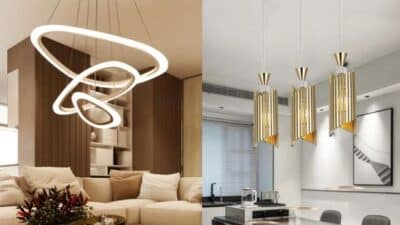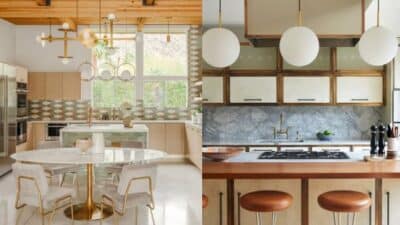Beige is making a significant comeback in interior design for 2025, offering a timeless and versatile choice that suits various aesthetics. Designers are embracing warm, inviting shades of beige to create spaces that feel luxurious yet comfortable. The trend emphasizes how beige can enhance a home’s serenity while easily pairing with other colors and materials.
This neutrally rich tone, such as Sherwin Williams’ Sunbleached, captures attention for its ability to redefine interiors. It allows individuals to incorporate high-quality materials like velvet and silk, adding elegance to any room. Whether used in a minimalist approach or as a backdrop for bold accents, beige is proving to be a favorite in modern design.
As homeowners seek a sense of calm in their living spaces, beige delivers warmth and tranquility, making it a popular choice across different styles. From chic urban apartments to cozy family homes, the 2025 color palette showcases beige as the ultimate comfort neutral, ready to transform any environment into a welcoming retreat.
Evolution of Beige in Interior Design


Beige has long been a staple in interior design, often seen as a safe and neutral choice. This classic color has evolved through the decades, adapting to changing tastes and styles.
In the early 2000s, beige dominated many homes due to its versatility. It paired well with various colors and offered a calming effect.
Recently, designers have begun to rethink this trend. As noted by interior designers, there is a notable shift from beige to more vibrant colors. Bright tones are now welcomed, signaling a movement toward a more lively aesthetic.
Despite this shift, beige is making a comeback. The trend of using it as a warm neutral in home decor highlights its renewed appeal. Designers are finding innovative ways to incorporate beige alongside other trendy colors.
Key Points of Beige’s Evolution:
- 2000s: Dominated as a go-to neutral.
- 2020s Shifts: Designers move toward bolder hues.
- Renewed Interest: Beige is used creatively in modern designs.
The connection between interior and exterior spaces, emphasized in biophilic design, also influences the use of natural tones like beige. This approach aims to create harmony within living environments.
As trends continue to evolve, beige may adapt yet again, finding its place in a colorful future.
Beige Color Palette for 2025
The beige color palette for 2025 emphasizes warmth and versatility, catering to modern aesthetics. It incorporates a variety of tones, allowing for both cozy and fresh environments. Here are the key elements of the palette.
Warm Beige Tones


Warm beige tones create inviting spaces. These hues blend well with natural light and wooden elements, fostering a cozy atmosphere. Popular options include:
- Sherwin Williams Accessible Beige (7036): This shade is known for its comforting warmth and adaptability.
- Benjamin Moore Swiss Coffee: A creamy shade that adds a soft, airy feel to interiors.
- Behr Crème Brûlée: This tone brings a touch of sweetness, perfect for living areas and bedrooms.
These warm beiges work wonderfully with wooden textures and earth tones, enhancing the feeling of warmth in a room.
Cool Beige Tones


Cool beige tones are ideal for those seeking a softer, more contemporary look. These shades typically incorporate hints of gray or taupe. Notable choices include:
- Sherwin Williams Moderate White (6140): This cool beige has a slight gray undertone that offers an elegant touch.
- Benjamin Moore Maritime: A light, fresh tone providing a tranquil backdrop for various decor styles.
- Farrow & Ball Skimming Stone: This shade effortlessly bridges warmth and coolness, making it versatile for many applications.
Cool beiges pair well with crisp whites and muted pastels, creating a serene environment.
Beige and Accent Colors


Incorporating accent colors can enhance the beige palette significantly. Complementary shades include:
- Tans and Browns: Pairing with deep browns or rich tans adds depth and sophistication.
- Soft Blues or Greens: These cooler tones create a refreshing contrast against warm beiges.
- Bold Accents: Splashes of mustard yellow or coral can create visual interest and liveliness.
Using these accents thoughtfully can transform a beige backdrop into a stunning, personalized space. Mixing various textures alongside these colors further enhances the warmth and character of the interior design.
Material Selection in Beige Interior
When designing with beige interiors, choosing the right materials is crucial for achieving a harmonious and inviting space. A thoughtful combination of natural and synthetic options can enhance the warm and soothing qualities of beige, making the environment feel cohesive and stylish.
Natural Materials


Natural materials play a vital role in beige interior design. They create warmth and texture, essential for a calming atmosphere. Common choices include:
- Wood: Light woods like oak and maple complement beige tones. They add warmth and a touch of nature.
- Stone: Materials such as limestone or marble can introduce subtle variation and organic beauty.
- Cotton and Linen: These fabrics provide comfort in upholstery and drapery, softening the overall look.
Incorporating these elements helps create a biophilic design. Natural materials enhance the indoor experience, promoting tranquility and connection to nature.
Synthetic Options


Synthetic materials offer a practical and often cost-effective alternative while still aligning with beige aesthetics. They can mimic natural textures and provide durability. Popular options include:
- Vinyl: Versatile and easy to maintain, vinyl comes in various colors and finishes, making it ideal for flooring or wall options.
- Polyester and Acrylic: These fabrics are durable and easy to clean, perfect for furniture and cushions, offering a wide range of patterns.
- Laminate: Often used for countertops or cabinetry, laminate can mimic natural stone or wood, providing an elegant touch without the higher cost.
Using synthetic materials allows for flexibility in design while ensuring longevity, making them valuable contributors to beige interiors.
Lighting and Beige Interiors
Lighting plays a crucial role in highlighting the warmth and nuances of beige interiors. Both natural and artificial lighting can significantly affect how beige appears in a space, influencing the overall mood and aesthetic.
Natural Lighting


Natural light is essential in enhancing beige tones. Rooms that receive ample sunlight can make beige walls appear brighter and more inviting. Natural lighting accentuates the warmth of beige shades, creating a cozy atmosphere.
For optimal effects:
- Placement: East-facing windows bring in warm morning light, while west-facing windows provide softer evening tones.
- Window Treatments: Sheer curtains can diffuse light, softening harsh rays without dimming the space too much.
It is beneficial to consider the direction of light throughout the day. Beige can look entirely different in morning, afternoon, and evening light. This dynamic quality makes natural light a key player in beige interior design.
Artificial Lighting


Artificial lighting complements natural light and can significantly impact how beige is perceived. Different types of fixtures and bulbs can enhance or alter the hue of beige, making it either warmer or cooler.
For effective artificial lighting:
- Layered Lighting: Incorporating ambient, task, and accent lighting creates depth. Use pendant lights or chandeliers for ambiance, table lamps for tasks, and wall sconces to highlight decor.
- Color Temperature: Warm white bulbs (2700K to 3000K) enhance the richness of beige, while cooler bulbs can make it feel more sterile.
Selecting the right fixtures and bulbs allows beige interiors to shine at any time of day, ensuring they remain inviting and stylish. Adjusting lighting can provide flexibility, allowing residents to alter the space’s atmosphere according to their preferences.
- 439shares
- Facebook0
- Pinterest439
- Twitter0


